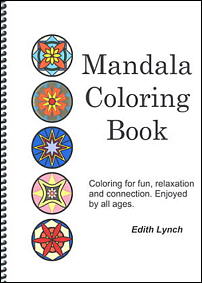Author: Edith Lynch
Negative self talk and the inner dialogue that is continuously present in our mind is the basis and expression of the reality we are creating. We need to suspend this inner talk to reach a state of awareness and to connect with our inner center of knowing and being.
In Mandala Coloring the focus is on the coloring and our inner dialogue is suspended. When this occurs there can be self discovery and an opening or ourselves to healing and creativity. The suspension of inner dialogue (which may be the “ego”) allows a different perspective for situations from our past and provides new solutions.
Carl Jung studied mandalas and he observed:
The “squaring of the circle” is one of the many archetypal motifs
which form the basic patterns of our dreams and fantasies. But it
is distinguished by the fact that it is one of the most important
of them from the functional point of view. Indeed, it could even
be called the archetype of wholeness.
Coloring a predetermined shape is a practice that can bring us into contact with a framework that already exists. This can lead to a better understanding of established structures, and provide an opportunity to connect to a part of us that is unchanging and steady. The simple act of coloring a mandala can provide an outlet for stress and a means to be brought back into peace and harmony.
Just as photograph reminds us of our family members and our place in the family, the mandala is a picture of who we really are. It can help us remember ourselves, and despite outer turmoil and chaos, it is a source of quiet.
While the creation of a mandala allows us to express a picture of our inner world as it may exist in an ego sense, coloring a mandala reminds us of the cosmic forces that rule our lives. It is bringing us back to our beginning and centering us in the reality that is our existence.
Mandala Interpretation is an interesting way to look at a Mandala
The first step in interpreting your mandala is to determine a title for your mandala. You can write down your title and then study it to identify any feelings or insights that may be apparent. Just write down what comes to you, and don’t spend a lot of time thinking about it.
Next, list the colors that you have used and after each color write an association to the color. There is no right or wrong to interpreting colors – you can write what the color is saying to you. Become aware of colors that you commonly use, and note any emotions or feelings. As well note any shapes that you see and write those down along with the associations that pop into your mind. After you have written those, note any patterns, themes or energies that seem to emerge. Write a few sentences about what you are feeling.
A Mandala Coloring Book gives you the basis for coloring and interpreting your mandala.
Article Source: http://www.articlesbase.com/stress-management-articles/meditation-through-mandala-coloring-472558.html
About the Author
Edith Lynch, M.Ed. is an Educator, Speaker and Workshop Facilitator. She has extensive training and experience in Teaching, Curriculum Development, Transformational Training, Transformational Leadership, Reiki I and II, and Law of Attraction.
——————————————————————————————————–
I look forward to your thoughts and comments!
Be sure to Subscribe to this blog either by RSS or Email via the forms on the top right column of the page.

